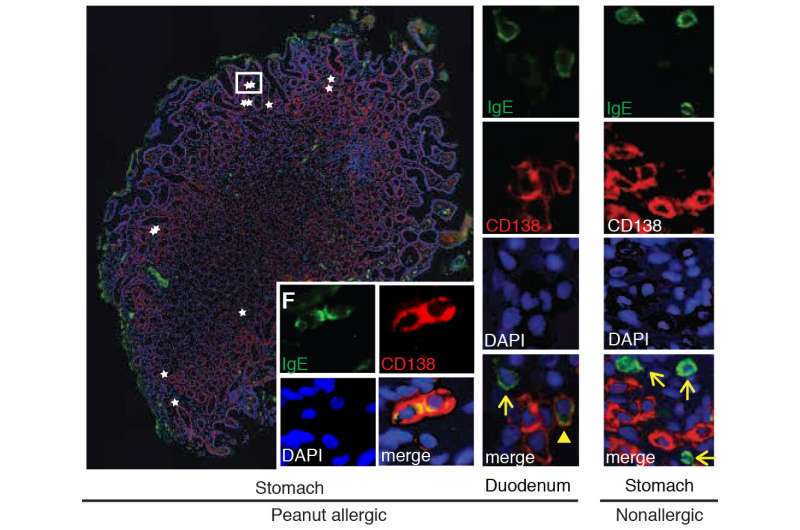March 6, 2020 report
High levels of immunoglobulin E antibodies in microbiomes of people with peanut allergies

A team of researchers from Stanford University, the University of Cincinnati and Cincinnati Children's Hospital Medical Center has found that people with peanut allergies have an abundance of allergy-causing immunoglobulin E antibodies (IgE) in their guts. In their paper published in the journal Science Immunology, the group describes sequencing antibody genes from B-lineage plasma cells collected from multiple body locations in people with peanut allergies and what they found. Duane Wesemann and Cathryn Nagler with Brigham and Women's Hospital and Harvard Medical School and the University of Chicago, respectively, have published a Perspective piece on the work done by the team in the same journal issue.
As the researchers note, an estimated 3 to 6 percent of the population of the U.S. has a food allergy—and recent studies have shown that the percentage is increasing. Because of that, researchers seek to better understand allergies and to stop them. In this new effort, the researchers were focused on the underlying cause of peanut allergies.
To gain a better understanding of the factors that lead to a peanut allergy, the researchers collected samples of B-lineage plasma cells (which produce IgE) from the esophagus, duodenum and stomach from 19 peanut allergy suffers, each of whom were about to take part in a clinical trial set to test the effectiveness of prescribed doses of peanut proteins for allergy treatment. The cells were then sequenced.
In studying their data, the researchers found an abnormal amount of IgE in the guts of the peanut allergy sufferers, and that many of them had similar peanut-reactive IgE genome sequences. They also found evidence showing that many of the plasma cells had undergone class switch recombination (CSR), in which a cell stops producing one type of antibody and starts producing another—in this case, IgE.
In addition to adding another piece to the puzzle of food allergies, the results suggest it might be possible to treat patients with peanut allergies with therapies that target the prevention of CSR. The results also suggest similar studies might aid in the development of therapies for other food allergies, as well.
More information: Ramona A. Hoh et al. Origins and clonal convergence of gastrointestinal IgE+ B cells in human peanut allergy, Science Immunology (2020). DOI: 10.1126/sciimmunol.aay4209
© 2020 Science X Network




















